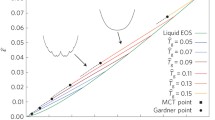Abstract
Available theories to explain the phenomenon of photomechanical behavior in solid materials below the transition temperature are qualitative in nature, and several distinct mechanisms are capable of producing a deformation birefringence. A new mechanism is proposed on the atomic level to account quantitatively for deformation birefringence in an ideal amorphous elastic solid. The material is an isotropic, statistically homogeneous, elastic medium consisting of a random spatial arrangement of heavy mass points (atom nuclei) with positive electric charge in static equilibrium with a corresponding number of continuous, spherical, negatively charged regions (electron clouds). The medium has a nonzero random initial polarization; changes in the components of the dielectric tensor at optical frequencies are computed for infinitesimal uniaxial strain using the Lorentz field approximation for isotropic media. The stress-optical constant is then computed from the associated change in refractive index, and is shown to be in good agreement with experimental values for ordinary photoelastic materials.
Similar content being viewed by others
Abbreviations
- A, A * :
-
arbitrary constants
- a :
-
a constant [eq (29)]
- B, B * :
-
arbitrary constants
- C :
-
photoelastic constant [eq (30)]
- D :
-
electric-displacement vector
- d :
-
vector from atom nucleus to electron-cloud center
- d o :
-
vectord in the initial state of zero strain and zero external electric field
- E :
-
vector of externally impressed electric field
- E * :
-
increment inE 0 produced byE
- E 0 :
-
internal electric-field vector in the material in the initial state of zero strain and zero external electric field
- E 1,E2,E3 :
-
component ofE in direction ofi 1, i2, andi 3, respectively
- e :
-
electron charge (−1.6×10−19 coulomb)
- F :
-
coulomb force vector
- i 1,i2,i3 :
-
unit vector in thex 1,x2,x3 direction, respectively (Fig. 1)
- K :
-
elastic stiffness of stretch ofd
- K T :
-
elastic stiffness of transverse change ind
- K 0 :
-
value ofK in the initial state
- M :
-
theoretical figure of merit of a photoelastic material [eq (32)]
- mθ:
-
number of dipole vectorsd associated with a unit solid angle in direction (θ,φ) (see Fig. 1) per unit initial volume of material
- N :
-
number of atoms/unit volume in the unstrained state
- n :
-
refractive index in the initial state
- n 1,n2,n3 :
-
refractive index associated with the principal directioni 1,i 2,i 3, respectively
- P :
-
electric-polarization vector
- P 1,P2,P3 :
-
component ofP directioni 1,i 2,i 3
- p :
-
atomic polarization vector [eq (17)]
- R :
-
radius of an electron cloud
- t :
-
uniaxial strain inx 1-direction
- t 1 :
-
principal-strain-component association with directioni 1
- x 1,x2,x3 :
-
rectangular Cartesian coordinates (Fig. 1)
- Y :
-
Young's modulus
- Z :
-
number of electrons per atom
- α:
-
electronic polarizability [eq (4)]
- ɛ:
-
dielectric constant of material in the initial state
- ɛ1,ɛ2,ɛ3:
-
principal value of dielectric-tensor association with directioni 1,i 2,i 3, respectively, in the strained state
- ɛυ:
-
dielectric constant in vacuum
- θ, φ:
-
spherical coordinates (Fig. 1)
- θo :
-
value of θ associated withd 0
- μ:
-
magnetic permeability
- μυ :
-
magnetic permeability of vacuum
- ν:
-
Poisson's ratio
- ρ:
-
nominal value of the electron volume/unit volume of material
- ψ:
-
solid angle
References
Treloar, L. R. G., The Physics of Rubber Elasticity, Oxford University Press, London (1958).
Kuhn, W. andGrün, F., “Beziehungen zwischen elastischen Konstanten und Dehnungsdoppelbrechung hochelastischer Stoffe”,Kolloid-Zeitschrift,101,248–271 (1942).
Read, B. E., “Dynamic Birefringence of Polymethylacrylate”,Polymer,5,1–18 (1964).
Blumstein, A., “Photoelastic Properties of Tightly Crosslinked Networks”,Jnl. Polymer Sci., Pt. A,2,769–784 (1964).
Coker, E. G. andFilon, L. N. G. A Treatise on Photo-Elasticity, 2nd ed., Cambridge University Press, Cambridge, England (1957).
Neumann, F. E., “Die Gesetze der Doppelbrechung des Lichtes in comprimierten oder ungelichforming erwärmten unkrystallinischen Körpern”,Abhandlungen der Königlichen Academie der Wissenschaften zu Berlin, Berlin, pt. II, 1–254 (1841).
Ambronn, H., “Ueber die akzidentelle Doppelbrechung in Zelloidin und in der Zellulose”, Göttingen Nachrichten (Math. Phys. Kl.), Heft 2, 299–320 (1919).
Kundt, A., “Ueber die Doppelbrechung des Lichtes in bewegten reibenden Flüssigkeiten”,Annalen, der Physik, Ser. 3,13,110–113 (1881).
Wert, C. A. andThomson, R. M., Physics of Solids, McGraw-Hill Book Co., New York (1964).
Lorentz, H. A., The Theory of Electrons, Dover Publications Inc., New York (1952).
Onsager, L., “The Electric Moments of Molecules in Liquids”,Jnl. Amer. Chem. Soc.,58,1486 (1936).
Wolf, H., Spannungsoptik, Springer-Verlag, Berlin (1961).
Author information
Authors and Affiliations
Rights and permissions
About this article
Cite this article
Lind, N.C. A microstructure theory of photoelastic behavior in amorphous solids. Experimental Mechanics 9, 424–428 (1969). https://doi.org/10.1007/BF02327009
Issue Date:
DOI: https://doi.org/10.1007/BF02327009




